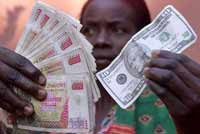Zimbabwe cuts ten zeros making ten billion dollars become one
Zimbabwe is going to remove ten zeros from its banknotes within the scope of the struggle against hyperinflation. The Central Bank of the poverty-stricken African nation will present the new Zimbabwean currency on August 1, 2008.

Hyperinflation in Zimbabwe has broken all records in the world. The new banknotes of the country will lose ten zeros at once and will be exchanged at the rate of one new Zimbabwean dollar to ten billion old Zimbabwean dollars.
“Ten billion Zimbabwean dollars will be equated to one Zimbabwean dollar from August 1,” Central Bank Governor Gideon Gono said in a statement.
The annual inflation rate in Zimbabwe reached the all-time record level of 2 million percent, sources at the government say. Independent experts believe that the real figure is five times as high. The statistics of appearance of new banknotes in Zimbabwe speaks for itself. Ten-million-dollar notes appeared in January of this year, 50-million notes followed in April, with 100 and 250-million notes in May and 5, 25 and 50-billion-dollar notes appeared in the country afterwards.
In July the Central Bank of Zimbabwe issued a 100-billion-dollar note.
The economy of Zimbabwe remains in deep crisis. The unemployment level in the country makes up 80 percent, whereas several millions of Zimbabweans have become refugees. The country suffers from a serious shortage of food and fuel.
The economic meltdown and repressive political measures in Zimbabwe have led to a flood of refugees into neighbouring countries. An estimated 3.4 million Zimbabweans, a quarter of the population, had fled abroad by mid 2007. Some 3 million of these have gone to South Africa.
Apart from the people who fled into the neighbouring countries, an estimated 570,000 people are displaced within the borders of the country, many of whom remain in transit camps and have limited access to assistance. Most of the displaced have been victims of the Operation Murambatsvina in the year 2005 and continuing evictions and violent farm seizures. Their plight is virtually impossible to assess, as there has been no national survey of people displaced since 2005.
However, these numbers are likely to have been exaggerated, as a study by the Forced Migration Studies Program of Witwatersrand University finds.
Subscribe to Pravda.Ru Telegram channel, Facebook, RSS!


